Greening your home at Christmas with holly, ivy, mistletoe and trees
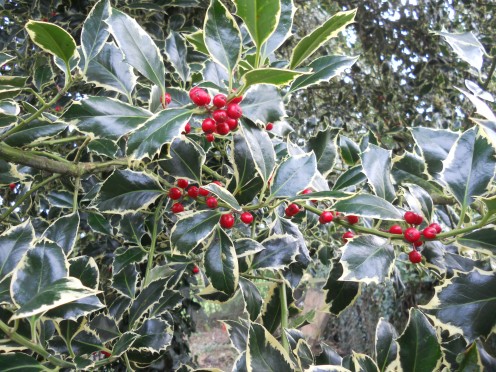
Traditional Christmas decorations include the use of evergreen shrubs placed around the house, boughs of prickly holly with its bright red berries, garlands of ivy, mistletoe hung above the doorway, and of course the traditional Christmas tree. The tradition of these decorations goes back a long way, and often pre-dates the meanings that we now associate with the Christian festival of Christmas, having pagan origins in western Europe.
Pagan rituals and celebrations revolved around the seasons and the cycle of life. The 21st of December is the winter solstice, the shortest day of the year, which was celebrated by pre-Christian peoples in Europe, as the time when the days start to get longer again, and to celebrate the coming of the new year.
The appeal of evergreens as decorations is obvious, bringing a splash of colour and life indoors in the depths of winter to brighten up the home.
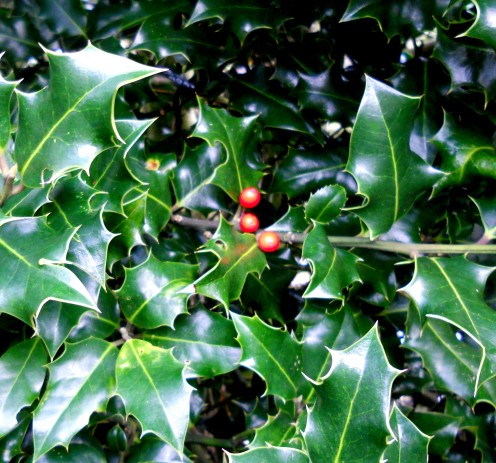
Holly
European holly, Ilex aquifolium, with its prickly glossy green leaves and bright red berries, has been used for a very long time as a winter decoration. In pagan symbolism it represented the masculine, and is opposite to the ivy, which represented the feminine form, so together they symbolise fertility. As evergreens they also symbolise everlasting life. Medieval folk songs tell of the struggles between the holly and the ivy - representing the age old battle of the sexes! In Christianity the holly wreath is associated with the crown of thorns, with the red berries representing the blood of Christ.
Holly is a common wild and garden shrub, but if you wish to grow holly that bears berries you will need both male and female shrubs growing in close proximity to each other, as only the female plant produces berries, and only if there is a male plant nearby to pollinate it. Holly is a very ecologically beneficial shrub to grow, as the berries are great for the birds in the depths of winter - although mildly toxic to humans, so be sure your children do not eat them. The plant also improves the soil, and some trees have been known to live up to 500 years old.
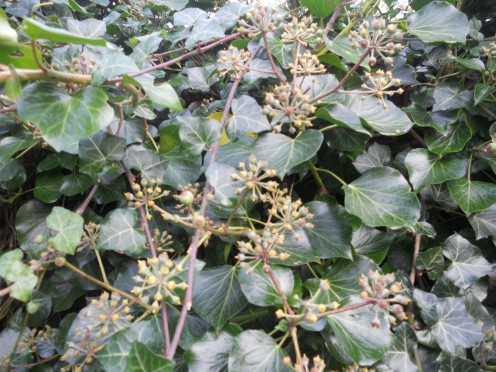
Ivy
Ivy is an evergreen creeping or climbing shrub, with the latin name Hedera helix. As mentioned above, in Pagan tradition ivy is representative of the female. It is sometimes thought of as a weed, that climbs all over bushes and fences in the garden and can be a nuisance, but it is also very decorative. An ivy bush that is allowed to grow to maturity will produce nectar rich flowers that are great for insects, and then, later in the season, the black berries are a valuable food source for garden birds. There are several decorative cultivars of ivy with variegated leaves that are used horticulturally, look very pretty climbing up a wall, and make fantastic Christmas garlands.
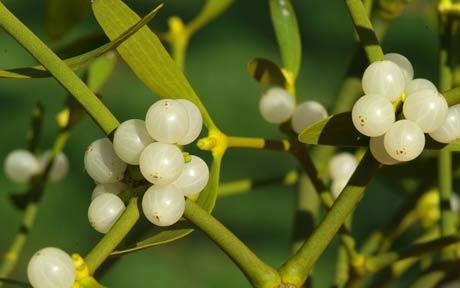
Mistletoe
European mistletoe, Viscum album, is another evergreen that bears sticky white berries. It is a parasitic plant that grows in the branches of deciduous woodland trees. The tradition of hanging mistletoe above the door goes back a long way - the custom was that young men were able to hijack young girls as they came through the door and kiss them under the mistletoe, and this custom has its roots in ancient pagan fertility rites. Mistletoe is particulartly revered by druids, and has many sexual and fertility connotations in ancient European folklore. European mistletoe has also been used in herbal medicine, is made into a herbal tea, has a number of medicinal uses, and there is some research into its anti-cancer properties. A very informative website for further reading is listed below.
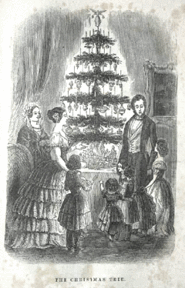
The Christmas Tree
The custom of decorating a tree at Christmas goes back at least as far as 15th Century Germany, Latvia and Estonia when it was traditional to have one in the village square. The custom later spread to having them in churches, and hospitals and eventually in the home. In Britain Queen Victoria popularised the use of decorated trees, and nowadays very few homes will be seen without a tree at Christmas. The print shown here of Queen Victoria's tree was first published the London Illustrated News in 1848, and then in America in Godey's Lady's Book in 1850, also spreading the popularity of the tree in the USA from then on.
The traditional tree to use is the Norwegian Spruce, and it could be a cut tree which is discarded after the holiday is over, a potted tree (with roots) that can be kept for future use or planted out in the garden, or an artificial tree that can be re-used every year.
A traditional Christmas carol
This song has always been one of my favourite Christmas carols, celebrating both nature and the true meaning of Christmas
The Holly and the Ivy
The holly and the ivy,
When they are both full grown,
Of all the trees that are in the wood,
The holly bears the crown.
Chorus:
The rising of the sun
And the running of the deer,
The playing of the merry organ,
Sweet singing in the choir.
The holly bears a blossom,
As white as the lily flower,
And Mary bore sweet Jesus Christ,
To be our sweet Saviour.
Chorus
The holly bears a berry,
As red as any blood,
And Mary bore sweet Jesus Christ
For to do us sinners good.
Chorus
The holly bears a prickle,
As sharp as any thorn,
And Mary bore sweet Jesus Christ
On Christmas Day in the morn.
Chorus
The holly bears a bark,
As bitter as any gall,
And Mary bore sweet Jesus Christ
For to redeem us all.
Chorus
The holly and the ivy,
When they are both full grown,
Of all the trees that are in the wood,
The holly bears the crown.
Chorus
Lyrics courtesy of Wikipedia, who took them from Sharp's English Folk-Carols, 1911.
Links for further reading
- Holly - Wikipedia, the free encyclopedia
- Ivy - Wikipedia, the free encyclopedia
- Mistletoe Pages: Homepage
... the Mistletoe Pages, which aim to provides helpful information on many aspects of mistletoe includng biology, conservation, control, traditions, harvesting, medicinal usage and traditions in art nouveau.








